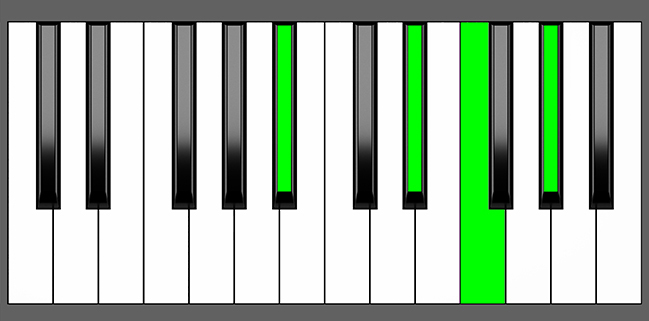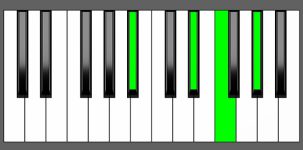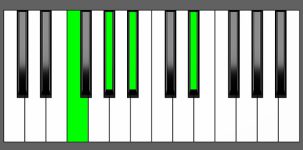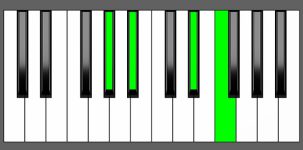Piano Diagram of A#7sus4 in Root Position

The A#7sus4 chord is made up of four notes, namely A#, D#, E#, and G#. This chord is known as a suspended second chord since the third note in the chord is substituted with a perfect fourth which creates a sense of suspension. To play the A#7sus4 chord on a piano, you simply need to replace the third note (Cx) of an A#7 chord with the fourth note (D#) from its root. Keep reading to get a better understanding of the music theory principles behind this chord.
Structure of A#7sus4
Notes |
|---|
| A#, D#, E#, G# |
Intervals |
|---|
| R, 4, 5, m7 |
Fingers Position
Left Hand |
|---|
| 5, 3, 2, 1 |
Right Hand |
|---|
| 1, 2, 3, 5 |
A#7sus4 Chord Inversions
The A#7sus4 chord has a total of 3 inversions:
| Root Position: | A# | D# | E# | G# |
| 1st Inversion: | D# | E# | G# | A# |
| 2nd Inversion: | E# | G# | A# | D# |
| 3rd Inversion: | G# | A# | D# | E# |
Piano Keyboard Diagrams
Music Theory and Harmony of A#7sus4
What are Suspended Chords?
Suspended chords are a type of chord in which the third note is replaced by either a major second or a perfect fourth. These resulting chords are called suspended second (sus2) or suspended fourth (sus4) chords, respectively. These chords create a unique and sometimes unresolved sound that can add tension and color to a musical composition.
Suspended chords have a distinct sound that sets them apart from major and minor chords. They are called suspended chords because they temporarily suspend the listener’s expectation of hearing a major or minor stable chord. Instead, they feature a perfect fourth or major second interval in place of the third. Due to their “neutral nature,” suspended chords can sometimes be used as substitutes for both major and minor chords.
The 7sus4 chord is a more intricate and richer version of sus4 chords, thanks to the inclusion of an extra minor 7th note. This additional note makes 7sus4 chords a more suitable choice for dominant and minor 7th chords.
Building the A#7sus4 Chord: Different Approaches
Starting from the A# major Scale
To build a 7sus4 chord, you can use the major scale as a guide and combine a root note, a perfect 4th, a perfect 5th, and a minor 7th interval.


To create an A#7sus4 chord, apply the formula R, 4, 5, m7 in the following manner:
- Begin with the Root note, A#.
- Select the 4th interval, D#.
- Add the 5th note, E# (which is an F but we’ll call it E# to preserve the basic structure of the chord).
- Finally, add the minor 7th interval, which is G#.
By following this simple formula, you can create a 7sus4 chord from any major scale.
by Combining Intervals
One method to create a dominant suspended 4th chord is by combining three specific intervals – a perfect 4th, a major 2nd, and a minor 3rd.
4 + 2 + m3 = 7sus4 Chords
To illustrate, let’s use the A#7sus4 chord as an example. By examining the intervals between the notes, we can see that
- A#-D# forms a perfect 4th interval,
- D#-E# creates a major second interval, and
- the interval between E# and G# is a minor 3rd.
How to Use A#7sus4 in a Chord Progression
Suspended chords have a unique quality that sets them apart from major and minor chords. They are considered neither major nor minor, which makes them a great tool for creating tension and suspense in a musical composition before resolving to a stable major or minor chord.
To incorporate an A#7sus4 into a chord progression, you can refer to the following tables, which outline the most common positions where the chord can be found or used.
However, it’s crucial to understand that, since this chord contains a minor 7th, it isn’t compatible with Maj7 chords, unlike sus2 or sus4 chords. Nevertheless, it can be used on dominant chords and on all positions where an A#m7 is present.
A#7sus4 as Substitute of A#7
A#7sus4 can be used as a substitute for A#7 chord in major and minor keys. In D# major, A#7 can be replaced with A#7sus4 in the V position. Similarly, in B# minor, the A#7 chord can be substituted with A#7sus4 in the VII position which is the leading tone chord.
However, since D# major is a theoretical key, it’s more practical to refer to its enharmonic equivalent key, Eb major, and use the equivalent chord of A#7sus4, which is Bb7sus4. The same principle applies to B# minor, G# major, and E# minor keys so we will refer to their enharmonic equivalent keys C minor, Ab major, and F minor.
on Major Scales
| Major Scales | I | ii | iii | IV | V | vi | vii |
|---|---|---|---|---|---|---|---|
| D# = Eb | Eb Maj7 | F min7 | G min7 | Ab Maj7 | Bb7 ⇒ Bb7sus4 = A#7sus4 | C min7 | Dm7b5 |
- Dominant chord in Eb Major as Bb7sus4
on Natural minor Scales
| Minor Scales | i | ii | III | iv | v | VI | VII |
|---|---|---|---|---|---|---|---|
| B# = C | C min7 | Dm7b5 | Eb Maj7 | F min7 | G min7 | Ab Maj7 | Bb7 ⇒ Bb7sus4 = A#7sus4 |
- Leading tone chord in C minor as Bb7sus4
A#7sus4 as Substitute of A# min7
The A#7sus4 chord can function as a substitute for the A# minor 7th in different major and minor keys. However, it’s important to note that some of these scales fall into the category of theoretical keys.
In music theory, a theoretical key refers to a key that exists in theory but is not commonly used in practice due to its impracticality. These keys often involve key signatures that require the use of double-flats or double-sharps, making the notation more complex and difficult to read.
To simplify notation and ensure practicality, it is recommended to refer to the enharmonic equivalent keys instead.
on Major Scales
| Major Scales | I | ii | iii | IV | V | vi | vii |
|---|---|---|---|---|---|---|---|
| G# = Ab | Ab Maj7 | Bbm7 ⇒ Bb7sus4 = A#7sus4 | C min7 | Db Maj7 | Eb7 | F min7 | Gm7b5 |
| F# | F# Maj7 | G# min7 | A#m7 ⇒ A#7sus4 | B Maj7 | C#7 | D# min7 | E#m7b5 |
| C# | C# Maj7 | D# min7 | E# min7 | F# Maj7 | G#7 | A#m7 ⇒ A#7sus4 | B#m7b5 |
- Supertonic chord in G# Major as Bb7sus4
- Mediant chord in F# Major
- Submediant chord in C# Major
on Natural minor Scales
| Minor Scales | i | ii | III | iv | v | VI | VII |
|---|---|---|---|---|---|---|---|
| A# | A#m7 ⇒ A#7sus4 | B#m7b5 | C# Maj7 | D# min7 | E# min7 | F# Maj7 | G#7 |
| E# = F | F min7 | Gm7b5 | Ab Maj7 | Bbm7 ⇒ Bb7sus4 = A#7sus4 | C min7 | Db Maj7 | Eb7 |
| D# | D# min7 | E#m7b5 | F# Maj7 | G# min7 | A#m7 ⇒ A#7sus4 | B Maj7 | C#7 |
- Tonic chord in A# minor
- Subdominant chord in F minor as Bb7sus4
- Dominant chord in D# minor
A#7sus4 in D# Major
A#7sus4 in B# Minor
A#7sus4 in G# Major
A#7sus4 in F# Major
When playing in the key of F# Major, the A#7sus4 chord can be used as a chord substitution for the diatonic A# minor chord that normally appears on the III degree of the scale.
| I | ii | iii | IV | V | vi | vii |
| F# Maj7 | G# min7 | A# min7 | B Maj7 | C#7 | D# min7 | E#m7b5 |
A#7sus4 Chord Progressions as iii degree
I iii IV V
| I | iii | IV | V |
| F# Maj7 | A#7sus4 | A#m7 | B Maj7 | C#7 |
I iii ii V
| I | iii | ii | V |
| F# Maj7 | A#7sus4 | A#m7 | G# min7 | C#7 |
I iii vi IV
| I | iii | vi | IV |
| F# Maj7 | A#7sus4 | A#m7 | D# min7 | B Maj7 |
A#7sus4 in C# Major
In the key of C# Major, the A#7sus4 chord can function as a submediant chord, which means it’s a chord built on the sixth degree of the scale. It can add variety and interest to a chord progression that already includes an A#m chord on the sixth degree.
| I | ii | iii | IV | V | vi | vii |
| C# Maj7 | D# min7 | E# min7 | F# Maj7 | G#7 | A# min7 | B#m7b5 |
A#7sus4 as vi degree – Chord Progressions
I iii vi V
| I | iii | vi | V |
| C# Maj7 | E# min7 | A#7sus4 | A#m7 | G#7 |
I vi ii V
| I | vi | ii | V |
| C# Maj7 | A#7sus4 | A#m7 | D# min7 | G#7 |
I IV ii V iii vi ii V
| I | IV | ii | V | iii | vi | ii | V |
| C# Maj7 | F# Maj7 | D# min7 | G#7 | E# min7 | A#7sus4 | A#m7 | D# min7 | G#7 |
A#7sus4 in A# Minor
When using the A#7sus4 chord in the key of A# minor, it can serve as a variation of the traditional A#m chord.
| i | ii | III | iv | v | VI | VII |
| A# min7 | B#m7b5 | C# Maj7 | D# min7 | E# min7 | F# Maj7 | G#7 |
A#7sus4 Chord Progressions as i degree
i VI VII
| i | VI | VII |
| A#7sus4 | A#m7 | F# Maj7 | G#7 |
i iv VI VII
| i | iv | VI | VII |
| A#7sus4 | D# min7 | F# Maj7 | G#7 |
A#7sus4 in E# Minor
A#7sus4 in D# Minor
In the key of D# minor, the A#7sus4 chord can function as a substitution or variation for the fifth chord, adding a unique tonal color to the progression. Pairing it with the A#7 chord on the fifth degree can create a sense of tension and expectation for the resolution to the tonic chord or to another chord of the scale.
| i | ii | III | iv | v | VI | VII |
| D# min7 | E#m7b5 | F# Maj7 | G# min7 | A# min7 | B Maj7 | C#7 |
A#7sus4 as v degree – Chord Progressions
i iv VI v
| i | iv | VI | v |
| D# min7 | G# min7 | B Maj7 | A#7sus4 | A#m7 |
i v VI VII
| i | v | VI | VII |
| D# min7 | A#7sus4 | A#m7 | B Maj7 | C#7 |
i VI v iv
| i | VI | v | iv |
| D# min7 | B Maj7 | A#7sus4 | A#m7 | G# min7 |
Alternative Names for A#7sus4 Chord
- A#7sus4
- A#7sus(4)
- A#7 add4(no3)
- A#7 add4(omit3)
- A# Dominant Suspended 4th



